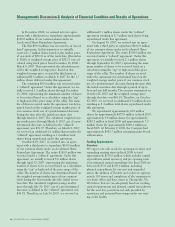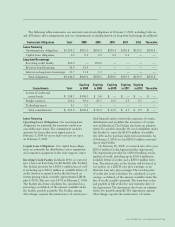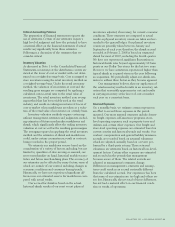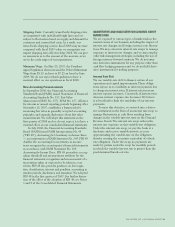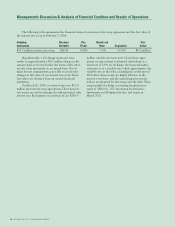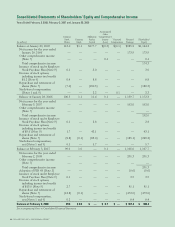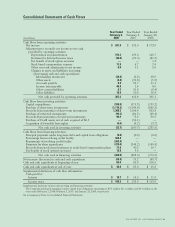Dollar Tree 2007 Annual Report Download - page 26
Download and view the complete annual report
Please find page 26 of the 2007 Dollar Tree annual report below. You can navigate through the pages in the report by either clicking on the pages listed below, or by using the keyword search tool below to find specific information within the annual report.
24
DOLLAR TREE, INC. • 2007 ANNUAL REPORT
Management’s Discussion & Analysis of Financial Condition and Results of Operations
Income Taxes
On a quarterly basis, we estimate our required income
tax liability and assess the recoverability of our
deferred tax assets. Our income taxes payable are esti-
mated based on enacted tax rates, including estimated
tax rates in states where our store base is growing,
applied to the income expected to be taxed currently.
Management assesses the recoverability of deferred tax
assets based on the availability of carrybacks of future
deductible amounts and management’s projections for
future taxable income. We cannot guarantee that we
will generate taxable income in future years.
Historically, we have not experienced significant dif-
ferences in our estimates of our tax accrual.
In addition, we have a recorded liability for our
estimate of uncertain tax positions taken or expected
to be taken in a tax return. Judgment is required in
evaluating the application of federal and state tax laws,
including relevant case law, and assessing whether it is
more likely than not that a tax position will be sus-
tained on examination and, if so, judgment is also
required as to the measurement of the amount of tax
benefit that will be realized upon settlement with the
taxing authority. Income tax expense is adjusted in the
period in which new information about a tax position
becomes available or the final outcome differs from
the amounts recorded. We believe that our liability for
uncertain tax positions is adequate. For further discus-
sion of our changes in reserves during 2007, see Note
3 to the Consolidated Financial Statements.
Seasonality and Quarterly Fluctuations
We experience seasonal fluctuations in our net sales,
comparable store net sales, operating income and net
income and expect this trend to continue. Our results
of operations may also fluctuate significantly as a
result of a variety of factors, including:
• Shifts in the timing of certain holidays, especially
Easter;
• The timing of new store openings;
• The net sales contributed by new stores;
• Changes in our merchandise mix; and
• Competition.
Our highest sales periods are the Christmas and
Easter seasons. Easter was observed on April 16, 2006,
April 8, 2007, and will be observed on March 23,
2008. We believe that the earlier Easter in 2008 could
potentially result in $25 million of lost sales when
compared to the first quarter of 2007. We generally
realize a disproportionate amount of our net sales and
of our operating and net income during the fourth
quarter. In anticipation of increased sales activity dur-
ing these months, we purchase substantial amounts of
inventory and hire a significant number of temporary
employees to supplement our continuing store staff.
Our operating results, particularly operating and net
income, could suffer if our net sales were below sea-
sonal norms during the fourth quarter or during the
Easter season for any reason, including merchandise
delivery delays due to receiving or distribution prob-
lems, consumer sentiment or inclement weather. Fiscal
2006 consisted of 53 weeks, commensurate with the
retail calendar. This extra week contributed approxi-
mately $70 million of sales in 2006 compared to
2007. Fiscal 2007 consisted of 52 weeks. In fiscal
2008, there is one fewer weekend between
Thanksgiving and Christmas compared to fiscal 2007.
We believe this could potentially reduce the total foot
traffic in our stores for the Christmas holiday in fiscal
2008 compared to fiscal 2007.
Our unaudited results of operations for the eight
most recent quarters are shown in a table in Note 12
of the Consolidated Financial Statements.
Inflation and Other Economic Factors
Our ability to provide quality merchandise at a fixed
price and on a profitable basis may be subject to eco-
nomic factors and influences that we cannot control.
Consumer spending could decline because of econom-
ic pressures, including rising fuel prices. Reductions in
consumer confidence and spending could have an
adverse effect on our sales. National or international
events, including war or terrorism, could lead to dis-
ruptions in economies in the United States or in for-
eign countries where we purchase some of our
merchandise. These and other factors could increase
our merchandise costs and other costs that are critical
to our operations, such as shipping and wage rates.








